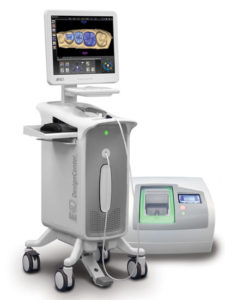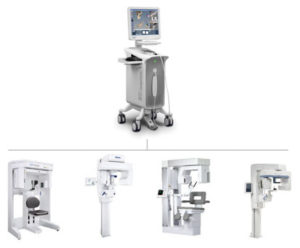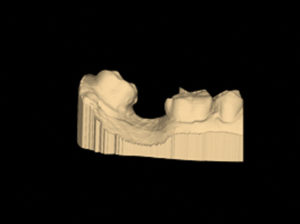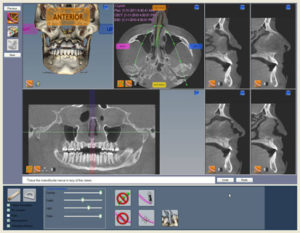By Curtis E. Jansen, DDS, Monterey, California
The E4D Dentist system has changed the way I practice—for the better.

Figure 1
I’m a prosthodontist practicing out of Monterey, California. I’ve got a progressive and successful practice with a great team assisting me in providing patients with excellence in dentistry every step of the way. I’ve had the E4D Dentist system for over three years now and it has provided my patients with a unique dental experience every time I’ve used it; digital impressions, restorations in one appointment, and quicker turnarounds with larger cases. All without compromise in form, fit, function, and esthetics. I’ve involved my whole team from Irma, my chairside assistant, who has become a CAD/CAM Dental Designer (CDD), and a Clinical Integration Specialist (CIS) to Frank, a dental technician with over 30 years bench experience—who is now “gaga” over what he can do with a mouse rather than a hot waxing instrument. I do it all—inlays, onlays, and crowns and veneers from single tooth to extensive cases. All are better when you have the E4D Dentist system by your side. Take my word for it— if you haven’t looked at this type of system in the last couple of years, you haven’t looked at all. And don’t believe what you’ve heard or seen before—this technology works!
But now it’s gotten even better and in a way that is most passionate to my interests in dentistry—implants. More specifically it provides all dental professionals a more predictable way to communicate with patients, specialists, and laboratories. It’s a way to get exactly what you’ve planned for—restorative-driven implant therapy—with E4D Compass

Figure 2
In the implant world, we’ve always talked a good game and have extensive preoperative plans with the laboratory, the surgeon, and the patient. Mocking up diagnostic plans, getting surgical stents and then hoping for the best as you send your patient along the implant placement trail. But, and you’ve all had it happen, something goes awry—the surgical stent doesn’t make it into the placement procedure or the surgeon puts the implant “where the bone is” and not necessarily where the restoration needs to be…then what? These surprise events in the continuum of implant therapy can set the final treatment plan back and dramatically increase the cost of treatment for the patient and the restorative dentist—let alone throw us all into a state of recovery and embarrassment.
Your Henry Schein Dental Sales Consultant can help you decide which one is right for you. Then get ready for E4D Compass—putting you and your surgeon on the same page!
Digital dentistry is coming to the rescue! With E4D Compass you’re able to combine cone beam data for the 3-D “internal” view of the patient along with intraoral data from E4D scans. Only the E4D Compass combines the data chairside from multiple sources and provides the clinician an intuitive planning process. E4D Compass works with leading dental cone beam manufacturers such as Imaging Sciences International, Gendex, Instrumentarium Dental, and SOREDEX for a complete solution.

Figure 3
Although other manufacturers have used a closed loop to simply export a static file into implant planning software, only D4D Technologies and the related cone beam systems have worked together to revolutionize the entire restorative/implant planning with E4D Compass. I don’t want to learn new surgical software—I’ve already invested time and effort learning my restorative software. Wouldn’t it be great if I could have all the data on my restorative cart – and be able to play, adjust, and design both the restoration and the implant placement all on the same screen? Well, that’s what we can do with E4D Compass—anything we want—at any stage of the game or plan. I can now draw a nerve the same way (using similar tools) as I draw a margin on a preparation. The interface is made for dentistry…for restorative dentistry.

Figure 4
Flexibility is the key! I know that the implant is not always going to be able to be placed exactly where I want it to be. Factors including bone density, dimensions, and nerve location all can dictate the final placement. But wouldn’t it be nice to know beforehand as you are designing the restoration? With E4D Compass, I can be flexible with my restoration design and implant placement all on the same screen and adjust both parameters (restoration and implant) rather than try to heroically save a situation with angled abutments, extensions and other compromises only on the restorative end. Optimize, don’t compromise.

Figure 5
I’ve been lucky enough to be involved and see the development of this exciting software program. It makes everyone’s “wish list” come true. I can draw the nerve(s), view the data from any angle, design the restoration that is right for the edentulous area, then choose one of a myriad of implants to place into the space using just a click and drag of a mouse. Nothing is this easy in dentistry. Then I can line up the implant with the ideal restorative placement, check the density of the bone, even the angulation of a proposed abutment—incredible. [See screenshots at the end of article.] This flexibility also allows for efficient and effective communication between the surgeon and the restorative dentist, and the laboratory if needed.

Screenshot
So what’s your next step? First, if you are a restorative dentist—get E4D Dentist system into your office (Figure 2): no powder, easy to use, makes any office more profitable by being able to complete same day dentistry or fabricate nearly all your single unit restorations. Get going with that system, and start scoping out the myriad of excellent cone beam systems listed above or locate a scanning center using one of those brands
(Figure 3). Why be tied into just one option? And, more importantly, why be tied into a closed system of the same manufacturer’s CAD/ CAM system and cone beam system? Be able to choose the best of both worlds and what is right for you.
Your Henry Schein Dental Sales Consultant can help you decide which one is right for you. Then get ready for E4D Compass—putting you and your surgeon on the same page! The more you grasp technology and use its capabilities to guide you to the ideal, the more efficient and effective you will become.

Screenshot
So here is your future dialogue with patients missing a tooth who come to see you for restorative therapy. Note: patients don’t come to you with the request for “an implant” they come to you to fill a missing space—it is up to you to offer the ideal restorative plan to fill that space first, then decide how you are going to put the restorative plan in place (bridge, implant; orthodontia). So let’s do that—design the ideal restoration then plan the mechanism to hold it in.
Okay Mrs. Smith, it is very important for you to replace that missing tooth with a “tooth” that will maintain the health of your mouth and will provide you function for chewing. We have several options to complete that goal, but let’s first scan the area with an advanced 3-D laser scanner so we can plan accordingly.
Take the E4D Scanner and capture a true 3-D image of the area—all soft and hard tissue. Note: No powder or contrast agent is placed. Think about it. This patient had just had the tooth extracted and there was still an open or healing wound. The last thing you’d want to do is spray titanium oxide under pressure into an open or healing wound. (So don’t go the powder route.)
Okay, so here is the 3-D virtual model

Screenshot
We can get a better idea of what the ideal restorative solution would be. The computer will assist us in previewing what would be the best functional and maintainable solution for your individual case. Here is the ideal proposal, which we can optimize for your individual situation prior to doing any treatment
It looks like one solution we should consider is a single-tooth implant that would hold the restoration in place and also provide you the most natural feeling and looking solution possible. But first we’ll need to look under your tissue to see if an implant is possible in that location.
Take them over to the i-CAT (or other compatible cone beam system) and complete a cone beam scan. Or if you’ve taken one before on any of the compatible systems, just grab the DICOM data.
So now we can see the bone available below your tissue. I’m going to combine this data right on this screen and show you what is possible. Here is the implant solution I would recommend and you can see I’ll place this directly under the restoration we’ve designed and see if you have the type and amount of bone ideal for this procedure (Figure 6).
We’ll identify the location of the nerve that runs down your lower jaw and certainly avoid that. With this software you and I can get a great view of the overall process before any treatment is started. So yes, it looks like this would be an ideal treatment. If we decide to go with this I have all the information I need. I can be ready when you are and in fact, I can prepare a temporary restoration and have it ready to place in that space the same day the implant is placed so you’ll never feel that open space again and your tissues will heal in the ideal form so when you’re ready the final restoration will be that much more natural and beautiful. Let’s get started!
E4D Compass will guide you in the right direction. Share your passion.
